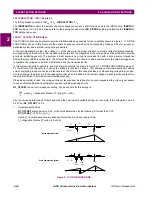
2-34
ALPS Advanced Line Protection System
GE Power Management
2.3 PROTECTION SETTINGS
2 CALCULATION OF SETTINGS
2
1302: TL4PICKUP: POTT1 Coordination Timer Pickup
•
POTT1 Scheme: For a POTT1 scheme, the pickup time delays of timers TL4 and TL1 provide transient-blocking coor-
dination to prevent a misoperation for current reversals that can occur when a fault on a parallel line is cleared sequen-
tially. If there is no parallel line, set TL4PICKUP to 0 and set TL1PICKUP as described above under TL1PICKUP. If
there is a parallel line, then use the following settings:
TL1PICKUP = 4 ms
TL4PICKUP = 13 ms + channel release time
Channel release time is defined as the time for the receiver at one end to drop out (release) after transmitter keying at
the other end has stopped.
•
PUTT Scheme: A PUTT scheme does not require a transient-blocking time delay. Since Zone 1 functions are used to
key the transmitter, the transmitter is not keyed to the TRIP frequency during an external fault, and there is no race
between the reset of the receiver and pickup of a local pilot overreaching function following current reversals associ-
ated with sequential clearing of faults on a parallel line. As such, set TL4PICKUP to 0.
1303: TL4DROPOUT - POTT1 Coordination Timer Dropout
•
PUTT and POTT1 Schemes: Set TL4DROPOUT to 0.
•
Step Distance, POTT2, Blocking and Hybrid Schemes: Timer TL4 is not used in these schemes therefore any
TL4DROPOUT setting that is made is irrelevant and will be ignored.
1304: TL5PICKUP - BKR1 b sw Coordination Timer Pickup
•
POTT1, POTT2 and PUTT Schemes: For these schemes, the breaker 52/b contacts are required to key the local
transmitter to the TRIP frequency when all three poles of the breaker(s) are open. TL5 and TL6 provide coordinating
times to synchronize the breaker 52/b switch contact operation with the opening and closing of the breaker's main
interrupting contacts. The pickup times (TL5PICKUP and TL6PICKUP) should be set so that an output will be pro-
duced just after the main contacts of the breaker open. The dropout times (TL5DROPOUT and TL6DROPOUT) should
be set so that the timer output resets just before the main contacts of the breaker close. The outputs of the timers are
ANDed together when two breakers are used. The switch shown below in Figure 2–13: TL5PICKUP / TL6PICKUP
REPRESENTATION is not a physical switch but rather a logical representation that is digitally controlled by General
Setting 105: NUM_BKR as described in Section 2.2.1: CONFIGURATION on page 2–2.
Figure 2–13: TL5PICKUP / TL6PICKUP REPRESENTATION on page 2–35 shows the connections for both three-
phase and single-phase tripping schemes. For three-phase tripping, the 52/b contacts are wired from breaker 1 to CC5
and from breaker 2 to CC6. For single-phase tripping, the 52/b contacts are wired from breaker 1 to CC8 (phase A),
CC9 (phase B), and CC10 (phase C). The outputs of TL5 and TL6 are also used by the ALPS to provide a time-tagged
event to indicate that the breaker is either open or closed.
•
Blocking and Hybrid Schemes: Keying of the transmitter is not required in these schemes; however, the ALPS uses
these timer outputs to provide a time-tagged event to indicate that the breaker is either open or closed. If these events
are required, then wire the 52/b contacts as shown in Figure 2–13: TL5PICKUP / TL6PICKUP REPRESENTATION on
page 2–35. The setting requirements for TL5 and TL6 are the same as described above.
1305: TL5DROPOUT - BKR1 b sw Coordination Timer Dropout
1306: TL6PICKUP - BKR2 b sw Coordination Timer Pickup
1307: TL6 DROPOUT - BKR2 b sw Coordination Timer Dropout
See description for TL5PICKUP (Protection Setting 1304).
1308: TL16PICKUP - Weak Infeed Trip Timer
The pickup delay of timer TL16 provides security in the weak infeed tripping logic. TL16PICKUP should be set long enough
to ride over any outputs from the receiver during weak fault conditions wherein weak infeed tripping is not desired (low level
faults beyond the remote line terminal for example).
If weak infeed tripping is used, TL16PICKUP should never be set greater than the pickup delay of timer TL11. For a Hybrid
scheme the pickup delay of TL11 is automatically set to 80 milliseconds for two-terminal applications (NUMRCVR = 1) and
50 milliseconds for three terminal applications (NUMRCVR = 2).
If weak infeed is employed and if the Zone 2 ground distance characteristic (Protection Setting 205) is set to GDOC or
MHOGDOC, then TL16 should never be set less than 16 milliseconds.
Содержание ALPS
Страница 2: ......
Страница 4: ......
Страница 182: ...5 20 ALPS Advanced Line Protection System GE Power Management 5 5 MOB TESTING 5 FUNCTIONAL TESTS FACTORY SETTINGS 5 ...
Страница 200: ...6 18 ALPS Advanced Line Protection System GE Power Management 6 5 ZONE REACH TESTS 6 FUNCTIONAL TESTS USER SETTINGS 6 ...
Страница 346: ...D 4 ALPS Advanced Line Protection System GE Power Management D 1 KEYPAD MENUS APPENDIXD D ...
Страница 352: ...F 2 ALPS Advanced Line Protection System GE Power Management F 1 WARRANTY INFORMATION APPENDIXF F ...
Страница 366: ...xiv ALPS Advanced Line Protection System GE Power Management INDEX INDEX ...




































